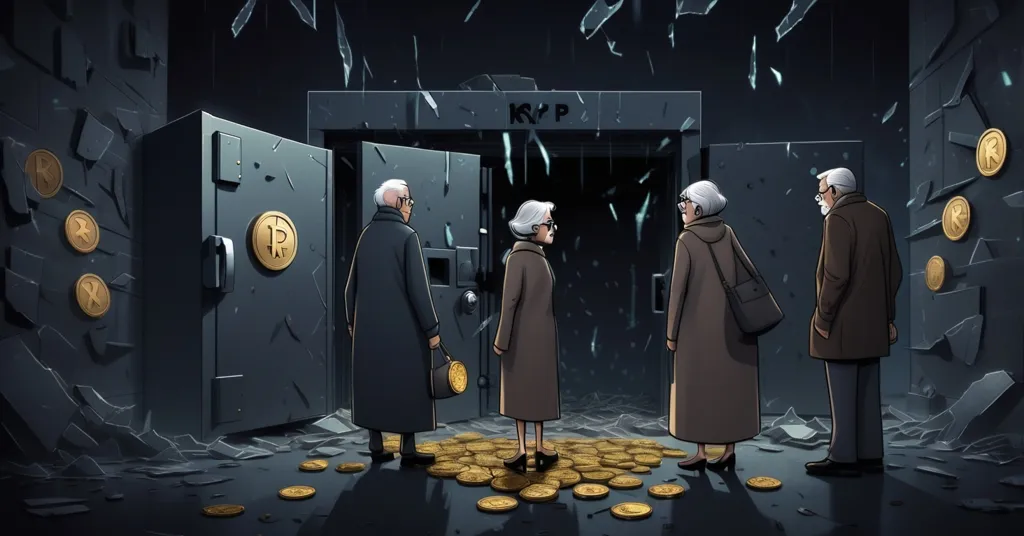North Carolina Couple Loses $3M in XRP Theft: Wallet Security Nightmare Unfolds

North Carolina Couple’s Life Savings Vanished in $3 Million XRP Theft
A retired couple from North Carolina, Brandon Laroque and his wife, endured a crushing blow on October 15, 2024, when over $3 million in XRP—their entire life savings—was stolen from their Ellipal mobile app wallet. This heartbreaking loss serves as a chilling reminder of the brutal risks in the cryptocurrency space and the urgent need for ironclad wallet security practices.
- Catastrophic Theft: Over $3 million in XRP stolen from Brandon Laroque’s Ellipal wallet on October 15, 2024.
- User Error Likely: Ellipal claims Brandon entered his seed phrase into the mobile app, exposing his cold wallet to online threats.
- Slim Recovery Odds: Funds were split, moved to Tron, and tied to shady OTC brokers, rendering recovery nearly impossible.
A Retiree’s Nightmare Unfolds
Brandon Laroque, a 54-year-old retiree, had been stacking XRP since 2017, seeing the cryptocurrency as a bedrock for his and his wife’s retirement. XRP, created by Ripple, offers fast transactions and low fees, often marketed as a tool for cross-border payments. For many investors like Brandon, it’s a way to hedge against the creaking traditional financial system. But on October 12, at around 11:15 a.m. Eastern Time, the first cracks appeared with two unnoticed test transactions of 10 XRP each. Three days later, disaster struck—1,209,990 XRP, worth over $3 million, was swept from his wallet to an unknown address in one ruthless move. You can read more about this devastating incident in a detailed report on the North Carolina couple’s massive XRP theft.
“That was everything we had. I’m speaking up because maybe someone out there can learn from what happened to us,”
Brandon shared, his words carrying the weight of regret and a faint hope to spare others from similar ruin.
Now, months after the theft, the couple struggles to rebuild. Brandon has expressed doubts about ever touching crypto again, haunted by the loss and frustrated by the lack of immediate support. Their story isn’t just a financial hit—it’s a gut punch to trust in a system meant to empower individuals.
How the Thieves Pulled It Off
The thieves struck with staggering speed and cunning. Within hours, the stolen XRP was split into tiny pieces across dozens, then hundreds, of wallets—a tactic called fragmentation that hides the money trail. Using a cross-chain swap tool called Bridgers (formerly SWFT), which lets users exchange tokens between blockchains with little oversight, the funds were moved from Ripple’s network to the Tron blockchain. Think of this as switching from one highway to another to throw off pursuers. The loot eventually consolidated into a single Tron wallet, address TGF3hP5GeUPKaRJeWKpvF2PVVCMrfe2bYw.
Tron’s blockchain has become something of a shady alley in crypto—fast, cheap, and often a hideout for crooks due to its lax oversight. On-chain investigator ZachXBT, a respected name in tracking illicit crypto flows, followed the trail further. He found the funds tied to over-the-counter (OTC) brokers linked to Huione, a Southeast Asian marketplace flagged by U.S. authorities for handling dirty money. OTC brokers are like underground money changers, trading crypto off the books and often dodging any scrutiny. Intriguingly, smaller holdings in Brandon’s wallet—$1,000 in Stellar (XLM) and $900 in Flare (FLR)—were left untouched. This selective hit suggests hackers zero in on high-value, liquid assets like XRP, a bitter lesson for altcoin investors spreading their bets.
“Once it’s bridged across chains and hits OTC desks, there’s almost no way back,”
ZachXBT warned, underscoring the bleak reality of recovery in such cases. He also flagged the danger of “crypto recovery” scams—predatory outfits that dangle false hope of retrieving funds for steep upfront fees.
Ellipal’s Defense: User Error or Design Flaw?
Ellipal, the wallet provider, didn’t hesitate to pin the blame on Brandon. On October 18, they stated he likely entered his seed phrase—a secret set of words that unlocks a crypto wallet—into the mobile app. This fatal move turned his cold wallet, meant to be secure and offline, into a hot wallet exposed to the internet’s many dangers. Ellipal stressed their hardware wallets are air-gapped, meaning completely disconnected from online networks like a safe with no keyhole, and claimed no history of theft with their physical devices. But let’s be real—if their app design is so confusing that a retiree can accidentally nuke their life savings, they’ve got blood on their hands, plain and simple.
Brandon pushed back, pointing to unclear design in the Ellipal app. On his iPhone, blue indicated cold storage; on his iPad, orange meant hot. A rookie mistake, sure, but one that could’ve been avoided with better cues.
“If the blue means cold and orange means hot, why wasn’t that made clearer?”
he asked, shining a light on a potential flaw that could trip up even careful users.
For context, Ellipal has marketed itself as a secure alternative to mainstream wallet providers, often touting its offline capabilities. Yet, user complaints about interface confusion have surfaced before, raising questions about whether their “foolproof” claims hold up under real-world use. The distinction between cold and hot storage isn’t just technical jargon—it’s the line between safety and ruin. A cold wallet, often a hardware device like a USB stick, keeps your keys offline, untouchable by hackers without physical access. A hot wallet, like a mobile app, is handy for quick trades but sits online, ripe for phishing or malware attacks. Entering your seed phrase into an app is like leaving your front door wide open with a neon “rob me” sign.
“I don’t know exactly how they got in. All I know is everything was there one day and gone the next,”
Brandon admitted, capturing the helpless dread so many crypto victims know too well.
The Dark Side of Blockchain Anonymity
Beyond Brandon’s personal hell, this theft exposes deeper rot in the crypto ecosystem. Since Bitcoin kicked off the decentralization party in 2009, and altcoins like XRP gained steam, millions have jumped into this space seeking freedom from bloated banks. But it’s still the Wild West out here. Hacks, scams, and boneheaded user errors wipe out fortunes in minutes. Blockchain’s anonymity—its greatest strength—also fuels its darkest corners. Once funds hit murky waters like Huione or vanish into Tron’s underbelly, they’re gone for good. No FBI report, no blockchain sleuthing, can undo that damage. Brandon reported the theft to the FBI’s Internet Crime Complaint Center and local police, only to hit a wall of bureaucratic red tape in accessing cybercrime experts.
Let’s not forget XRP’s unique risks either. Unlike Bitcoin, which prioritizes security over speed and has an unblemished record of network integrity, XRP’s centralized roots through Ripple and its high liquidity make it a juicy target for thieves. Quick transactions mean quick heists—hackers can liquidate XRP faster than they can move Bitcoin, which often takes longer to confirm on-chain. This incident isn’t isolated; crypto thefts have spiked in 2024, with altcoin holders frequently in the crosshairs, per recent Chainalysis reports. The psychological toll is just as brutal—studies show victims of crypto theft often grapple with stress, anxiety, and a shattered sense of trust in digital finance.
Playing Devil’s Advocate: Who’s Really at Fault?
Now, should we, as crypto diehards, own up to our slice of these disasters? Ellipal’s cold response isn’t entirely off-base. Crypto’s core ethos is self-custody—you’re your own bank, sink or swim. Expecting wallet providers to hold your hand through every click undercuts the decentralization we preach. If you wouldn’t leave your life savings in an unlocked car, why treat your seed phrase any less seriously? Personal accountability isn’t just a buzzword; it’s survival.
Yet, there’s a flip side, even for us Bitcoin maximalists. While BTC reigns as the gold standard of security—its network has never been breached—altcoins like XRP fill gaps Bitcoin doesn’t. Speedy transfers and cross-border utility have real value in pushing mainstream adoption, even if they come with extra baggage. And let’s not let Ellipal off the hook—confusing interfaces and half-assed warnings are inexcusable when millions are on the line. There’s a middle ground: providers must build idiot-proof tools, and users must step up their game. If we’re serious about disrupting the status quo and accelerating this financial revolution, ignoring the dark side—scammers, thieves, and sloppy design—isn’t an option.
Actionable Security Tips for Crypto Holders
Brandon’s ordeal is a brutal wake-up call for anyone in crypto, from greenhorns to OGs. Security isn’t a one-and-done checkbox; it’s a relentless mindset. Here are hard-hitting tips to keep your funds safe and out of the sharks’ jaws:
- Never Share Your Seed Phrase: Treat it like your social security number—don’t enter it into any app, website, or device connected to the internet. Write it down on paper and store it in a fireproof safe or split it across multiple secure locations.
- Use Cold Storage for Big Holdings: Keep large sums in hardware wallets like Ledger or Trezor, disconnected from the web. Only use/hot wallets (mobile or desktop apps) for small, day-to-day amounts you’re okay losing.
- Diversify Wallets: Don’t put all your eggs in one basket. Spread holdings across multiple wallets or even blockchains to limit damage if one gets compromised. Note that Bitcoin’s slower transaction speeds often deter quick heists compared to altcoins like XRP.
- Enable Two-Factor Authentication (2FA): Add an extra layer of defense on any hot wallet or exchange account with 2FA, preferably through an authenticator app, not SMS, which can be hacked via SIM swaps.
- Avoid Public Wi-Fi: Never access crypto apps or wallets on public networks—hackers can snoop on unsecured connections. Use a VPN if you must, but home networks are safer.
- Double-Check Everything: Before any transaction, verify wallet addresses character by character. Scammers often use lookalike addresses to trick users. And if a wallet app’s interface confuses you, reach out for clarification before proceeding.
These steps aren’t optional—they’re your lifeline. Even the best hardware wallet won’t save you if you’re careless. And next time a provider brags about “unhackable” tech, dig deeper. Your life savings depend on it.
Key Questions and Takeaways on Crypto Theft and Security
- What caused the theft of Brandon Laroque’s $3 million in XRP?
Ellipal points to user error, likely Brandon entering his seed phrase into the mobile app, turning a secure cold wallet into a vulnerable hot wallet open to online hacks. - Can stolen cryptocurrency be recovered after such a theft?
It’s almost impossible once funds are split across wallets, bridged to chains like Tron, and funneled through OTC brokers tied to illicit hubs like Huione, as ZachXBT explained. - How vital is user education in preventing crypto losses?
Absolutely critical—Brandon’s case shows how not grasping basics, like keeping seed phrases offline, can lead to ruinous losses in a heartbeat. - What responsibility do wallet providers like Ellipal carry?
They must craft intuitive tools with glaring warnings to stop user errors. Confusing designs, like unclear cold vs. hot storage indicators, play a direct role in preventable disasters. - How do thieves hide stolen crypto so effectively?
They split funds into countless wallets, swap them across blockchains using tools like Bridgers, and move them through unregulated OTC desks, vanishing into the crypto black market.
The promise of decentralization and financial freedom through Bitcoin and beyond is damn real, but so are the predators lurking in this space. Brandon’s loss isn’t a reason to ditch crypto—it’s a call to arm yourself with knowledge and demand better from the tools we rely on. Your wallet’s only as safe as your smarts. Don’t let the sharks smell blood, or you’ll be chum in no time.



